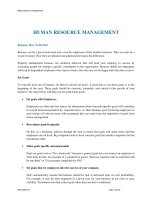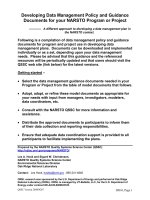Chap 12a dealing with employee management issues and relationships
Bạn đang xem bản rút gọn của tài liệu. Xem và tải ngay bản đầy đủ của tài liệu tại đây (839.81 KB, 54 trang )
Chapter Twelve
Dealing with Employee-Management Issues and Relationships
McGraw-Hill/Irwin
Copyright © 2010 by the McGraw-Hill Companies, Inc. All rights reserved.
ORGANIZED LABOR
•
Unions -- Employee organizations whose main goal is to represent members in employeemanagement negotiations of job-related issues.
•
Labor unions were responsible for:
-
Minimum wage laws
Overtime rules
Workers’ compensation
Severance pay
Child-labor laws
Job-safety regulations
12-2
PUBLIC SECTOR
LABOR UNIONS
•
Public sector union members work for governments as teachers, firefighters, police
officers, etc.
•
Many states face serious debt problems and want to cut labor costs. But states with
public sector unions have limited ability to cut those costs.
12-3
GOALS of ORGANIZED LABOR
•
To work with fair and competent
management.
•
To be treated with human dignity.
•
To receive a reasonable share of
wealth in the work it generates.
12-4
Labor Union History
12-5
HISTORY of
ORGANIZED LABOR
•
Craft Union -- An organization of skilled specialists in a particular craft or trade.
•
As early as 1792, shoemakers in a Philadelphia craft union met to discuss
fundamental work issues.
•
Work weeks were 60+ hours, wages were low
and child labor was rampant.
12-6
EMERGENCE of LABOR ORGANIZATIONS
•
Knights of Labor -- First national labor union; formed in 1869.
•
Knights attracted close to 800,000 members but fell from
prominence after a riot in Chicago.
•
American Federation of Labor (AFL) -- An organization of
craft unions that championed fundamental labor issues; formed in
1886.
12-7
INDUSTRIAL UNIONS
•
Industrial Unions -- Labor unions of unskilled or semiskilled workers
in mass production industries.
•
Congress of Industrial Organizations (CIO) -- Union organization
of unskilled workers; broke away from the AFL in 1935 and rejoined in
1955.
•
The AFL-CIO today has affiliations with 56 unions and about
12.2million members.
12-8
Labor Legislation
12-9
EFFECTS of LAWS on
LABOR UNIONS
•
Labor unions’ growth and influence has been very dependent on public opinion and
law.
12-10
EFFECTS of LAWS on
LABOR UNIONS
Pro-Labor Legislation
12-11
EFFECTS of LAWS on
LABOR UNIONS
Norris-La Guardia Act
Paved way for union growth
•
The Norris-LaGuardia Act helped unions by
prohibiting the use of Yellow-Dog Contracts -- A type
of contract that required employees to agree to NOT
join a union.
12-12
EFFECTS of LAWS on
LABOR UNIONS
National Labor Relations Act (NLRA)
Wagner Act
Legal justification for union activities
Collective Bargaining
National Labor Relations Board
Certification and Decertification
12-13
EFFECTS of LAWS on
LABOR UNIONS
•
Collective Bargaining -- The process whereby union and management representatives
form an agreement, or contract, for employees.
12-14
FORMING a UNION
in the WORKPLACE
•
The National Labor Relations Board (NLRB) was created to oversee labormanagement issues and provide guidelines for unionization.
12-15
FORMING a UNION
in the WORKPLACE
•
Certification -- The formal process by which a union is recognized by the NLRB as the
bargaining agent for a group of employees.
•
Decertification -- The process whereby employees take away a union’s right to represent
them.
12-16
EFFECTS of LAWS on
LABOR UNIONS
Pro-Management Legislation
12-17
EFFECTS of LAWS on
LABOR UNIONS
Labor-Management Relations Act
Taft-Hartley Act (1947)
12-18
LABOR/MANAGEMENT
AGREEMENTS
•
Union Security Clause -- Stipulates workers who reap union benefits must either join the
union or pay dues to the union.
12-19
UNION SECURITY AGREEMENTS
•
Closed Shop Agreement -- Specified workers had to be members of a union before
being hired for a job.
12-20
UNION SECURITY AGREEMENTS
•
Union Shop Agreement -- Declares workers don’t have to be members of a union to be
hired but must agree to join the union within a specific time period.
However…
12-21
UNION SECURITY AGREEMENTS
The Taft-Hartley Act also granted states the power to outlaw union shop agreements.
This led to the creation of the Agency Shop Agreement
12-22
UNION SECURITY AGREEMENTS
•
Agency Shop Agreement -- Allows employers to hire nonunion workers who don’t have
to join the union, but must pay fees.
12-23
UNION SECURITY AGREEMENTS
Also,
because the Taft-Hartley Act granted states the power to outlaw union shop
agreements, some states passed…
12-24
RIGHT-to-WORK LAWS
•
Right-to-Work Laws -- Legislation that gives workers the right, under an open shop, to
join or not to join a union,
which created the…
•
Open Shop Agreement -- Agreement in right-to-work states that gives workers the right to
join or not join a union, if one exists in their workplace.
12-25









